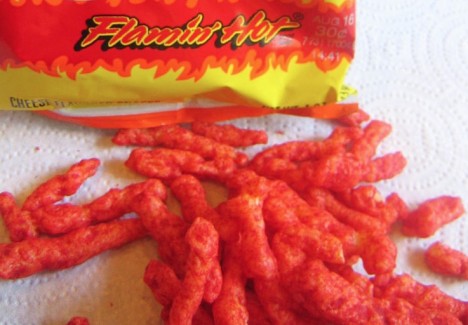Junk Food Makers Gaming School ‘Smart Snack’ Standards to Keep Kids Eating Flamin’ Hot Cheetos
(CC BY-NC-SA 2.0) Jason Brackens/Flickr Flamin’ Hot Cheetos are catnip for school kids for a lot of reasons: their tongue-toasting spiciness, their satisfying crunchiness, the way that they turn your fingers red instead of ordinary Cheetos orange, and of course, the fact that they are junk food, with scant more nutritional content than a poker chip. Flamin’ Hot Cheetos are also, according to the revised federal nutrition guidelines for America’s public schools, a “Smart Snack.” The guidelines were assembled by the Institute of Medicine and issued by the Obama administration last year, and the Cheetos “Smart Snack” designation, aside from making one wonder what the hell a dumb snack would be, is an illustration of how the food industry


(CC BY-NC-SA 2.0) Jason Brackens/Flickr
Flamin’ Hot Cheetos are catnip for school kids for a lot of reasons: their tongue-toasting spiciness, their satisfying crunchiness, the way that they turn your fingers red instead of ordinary Cheetos orange, and of course, the fact that they are junk food, with scant more nutritional content than a poker chip.
Flamin’ Hot Cheetos are also, according to the revised federal nutrition guidelines for America’s public schools, a “Smart Snack.” The guidelines were assembled by the Institute of Medicine and issued by the Obama administration last year, and the Cheetos “Smart Snack” designation, aside from making one wonder what the hell a dumb snack would be, is an illustration of how the food industry finesses the intent of nutritional standards and games the system of USDA regulations.
They’re not smart: only slightly less stupid
The guidelines required that food items sold in public schools be made healthier, but defined that as meaning less fatty, less salty, and containing whole grains. So Frito-Lay, the maker of Cheetos, switched to a formula that included somewhat less fat and sodium and more whole grains. But the result is still a Cheeto, and still nutritionally bereft, and not at all what the scientists who wrote the guidelines were aiming for. Which was, according to Virginia Stallings, a pediatrics professor and the chairperson of the guideline-writing committee, “things that had more nutrients in them than Flamin’ Hot Cheetos.”
The basic idea of the new nutrition rules was to reduce the kids’ intake of junk food at school by offering more nutritional snack alternatives, not merely replacing junky snacks with slightly less junky versions. As NYU nutrition prof Marion Nestle observed on National Public Radio, “Is a ‘better-for-you’ junk food a good choice? Of course it’s not.”
The guidelines were hoping for the good and the healthy; instead, in all too many instances they got the less bad and the less unhealthy, which is not the same thing. One bullet wound is better for you than two bullet wounds, but you’re still shot and bleeding.
Stallings acknowledges that the guideline-writing committee knew up front that “the food companies would look at these recommendations and they would, in fact, reformulate their products” to meet the letter, but not the spirit, of the regs. The committee members also knew that if they beefed up the nutritional content requirements of those guidelines to a really meaningful degree, they could well wind up with no guidelines at all.
Schools profit from junk food sales
Even the kid glove regulations they finally produced have been rejected as too severe and binding by more than 20 states. And there has been public grousing by both state and federal lawmakers that the students’ freedom of choice has been restricted, the healthy food alternatives are unpopular, and, horror of horrors, school revenues from junk food and vending machine sales are imperiled.
Might Congress simply snuff the life out of the pro-nutrition guidelines with legislation specifically permitting public schools to offer or not offer whatever food items they please? Well, it just cranked out a federal budget that provides the Food and Drug Administration with less than half the $580 million the FDA will need to implement the Food Safety Modernization Act, designed to reduce the 48 million illnesses and 3,000 or so deaths due to contaminated food each year. So healthy food is evidently low on their priorities list.
If this strikes you as the height of stupidity, well, maybe our esteemed Congresspersons have just been eating too many Smart Snacks. That stuff will rot your brain.
Junk Food Makers Gaming School ‘Smart Snack’ Standards to Keep Kids Eating Flamin’ Hot Cheetos is a post from:
SOURCE: – Read entire story here.







